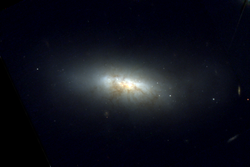| NGC 839 | |
|---|---|
 HST image of NGC 839 | |
| Observation data (J2000 epoch) | |
| Constellation | Cetus |
| Right ascension | 02h 09m 42.929s [1] |
| Declination | −10° 11′ 02.71″ [1] |
| Redshift | 0.012916 [2] |
| Heliocentric radial velocity | 3847 km/s [2] |
| Distance | 174.3 ± 12.2 Mly (53.44 ± 3.75 Mpc) [1] |
| Apparent magnitude (V) | 11.42 [2] |
| Apparent magnitude (B) | 13.98 [2] |
| Characteristics | |
| Type | S0: pec [1] |
| Other designations | |
| MCG -02-06-034, PGC 8254 [2] | |
NGC 839 is a lenticular galaxy located in the constellation Cetus. It was discovered November 28, 1785 in a sky survey by Wilhelm Herschel. [3] It is one of the galaxies that are part of the quadruplet family HGC 16, along with the unbarred lenticular galaxy NGC 838. [2]
NGC 839 is a luminous infrared galaxy (LIRG) that shows signs of high amounts of star formation; therefore, it is also classified as a starburst galaxy. [4] It is similar in appearance to Messier 82, suggesting a similar formation history. [4]